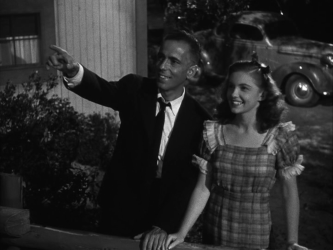I probably would’ve given this Humphrey Bogart double-feature (High Sierra along with The Big Sleep) a miss, as it wasn’t one of our scheduled days for movies and required accommodations be made, but we did basically start our old-time classics streak with The Maltese Falcon, and The Flower loves the era, the style and Bogie to boot, so I could hardly dampen her enthusiasm. Also, The Big Sleep is part of the inspiration (along with, I believe, Murder, My Sweet) for The Big Lebowski, and you know how we are about that particular flick (in the parlance of our time).
Too, I hadn’t actually seen High Sierra which sees Bogie in the last of his 2-bit gangster roles—the one that made him such a hit that he didn’t want to do Casablanca. He had to fight for this role, with director Raoul Walsh seeing him as a supporting player and the studio wanting big shot (of the time) Paul Muni in the lead. But Muni hated the script and demanded a rewrite, after which he still hated the script and after everyone else in the world turned it down, Bogart entered movie history.

Followed by the sequels “Higher Sierra” and “Highest Sierra”.
The thing about this movie is that it’s like a ’40s version of, say, The Girl on the Train, where a popular novel has hit it big and the studios line up to make a movie about it. Or maybe it’s more like a Michael Crichton story. I don’t know any more which writers Hollywood is lining up to produce these days. But back in the day, it was W.R. Burnett, who wrote bestselling novels (with a crime or urban feel, back when “urban” meant Italian, probably) and award winning screenplays, and was a script doctor to boot.
Burnett had written the novel High Sierra, and worked on the screenplay with John Huston. He also wrote the novel The Asphalt Jungle, which ended up being made into a movie by John Huston, and Little Caesar. No lightweight, dude.
And, perhaps predictably, this movie is an amalgam of many of the gangster clichés of the ’30s. Bogie plays a guy who’s just gotten out of prison. He’s thinking about going straight, but it doesn’t last long, because his boss Big Mac’s got an idea, see, a good heist set up, but he needs a seasoned pro managing the twerps, the soda jerks, the screwballs and the young jitterbuggers he’s gotta deal with today.

From left to right: Bogie, screwball, screwball, jitterbugger, screwball.
Heh. Yeah, this movie is jam packed with ’30s movie-gangster talk, and as we all know: the cheaper the crook, the gaudier the patter.
Playing opposite Bogie is the great Ida Lupino who was quite dishy in her day. (We know her best around here for her ’70s TV work on “Columbo” and the “classic” The Devil’s Rain.) She plays a desperate dime-a-dance girl who’s hooked up with one of the new twerps that don’t know no better than to bring a dame on a heist. The twerps are Alan Curtis (who died at 44 from complications after a routine kidney surgery, alas) and Arthur Kennedy, who would go on to be nominated five times for Academy Awards, all of which he would lose. They end up fighting over Marie (top-billed Lupino) who ends up crashing with the much stabler, good-guy gangster Roy (Bogie).
But the real fly in the ointment is Mendoza, the greasy Spaniard, played by the Hungarian-Mexican Cornell Wilde. (I’m joking about the Mexican part, obivously.) Wilde would go on to remake Apocalypto some 40 years before Mel Gibson directed it, in an under-rated gem called The Naked Prey. (When I worked at Paramount, one of the ladies had a full-sized Wilde cutout from that film, in which he is mostly naked and, yes, even in his 50s he was a handsome, handsome fellow.)

Bogie, Lupino, and Bogie’s actual dog.
So, Bogie’s got his hands full wrangling the idiots, the backstabbers, and the dopey dames, all the while pining for a good farmer’s daughter (the gorgeous Joan Leslie who, like Wilde, would close out her career on Angela Lansbury’s “Murder She Wrote”). The farmer’s daughter is one clubbed-foot operation away from a floozy, though, and our sensitive, murderous gangster ends up settling for his second best.
The Hays Office would not! could not! allow the book’s happy ending, though, and the movie actually finds its way into the titular High Sierras for the final shootout.

Sure, she looks sweet now, but fix that club foot…
This movie is just dripping with essential ’30s-ness. The only thing really missing is that Bogie doesn’t have a brother or childhood friend who joined the priesthood/police force. But it’s one of those things that sort of laps itself: If it might have been (I’m just guessing) perceived as hokey by the ’50s, we’re far enough away to enjoy the pure action/suspense/romance angle of it by now.
We all really liked it.
Universal Horror fans will recognize “Doc” as Henry Hull in what some would say was the best werewolf film, 1935’s Werewolf of London. (And his hair looked fabulous!)

One thought on “High Sierra (1941)”